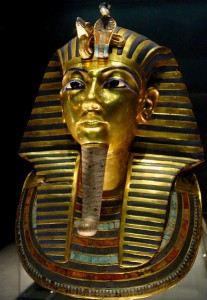Good morning.
Saturday in Whitewater will bring a slight chance of flurries, a high of eighteen, and partly sunny skies.
On this day in 1923, an archaeological wonder:

[I]n Thebes, Egypt, English archaeologist Howard Carter enters the sealed burial chamber of the ancient Egyptian ruler King Tutankhamen….When Carter arrived in Egypt in 1891, he became convinced there was at least one undiscovered tomb–that of the little known Tutankhamen, or King Tut, who lived around 1400 B.C. and died when he was still a teenager. Backed by a rich Brit, Lord Carnarvon, Carter searched for five years without success. In early 1922, Lord Carnarvon wanted to call off the search, but Carter convinced him to hold on one more year.
In November 1922, the wait paid off, when Carter’s team found steps hidden in the debris near the entrance of another tomb. The steps led to an ancient sealed doorway bearing the name Tutankhamen. When Carter and Lord Carnarvon entered the tomb’s interior chambers on November 26, they were thrilled to find it virtually intact, with its treasures untouched after more than 3,000 years. The men began exploring the four rooms of the tomb, and on February 16, 1923, under the watchful eyes of a number of important officials, Carter opened the door to the last chamber.
Inside lay a sarcophagus with three coffins nested inside one another. The last coffin, made of solid gold, contained the mummified body of King Tut. Among the riches found in the tomb–golden shrines, jewelry, statues, a chariot, weapons, clothing–the perfectly preserved mummy was the most valuable, as it was the first one ever to be discovered. Despite rumors that a curse would befall anyone who disturbed the tomb, its treasures were carefully catalogued, removed and included in a famous traveling exhibition called the “Treasures of Tutankhamen.” The exhibition’s permanent home is the Egyptian Museum in Cairo.
On 2.16.1943, the Nazis execute a Milwaukee native and leader of a small German resistance:
1943 – Mildred Harnack Guillotined in Berlin
On this date Mildred Harnack was guillotined in Berlin, Germany. Harnack was born in Milwaukee and studied and lectured at the University of Wisconsin. She and her husband, Arvid Harnack, were key members of a German resistance group which assisted German Jews and political dissidents, circulated illegal literature, met secretly with prisoners of war, and worked to document Nazi atrocities in Europe. Known by the Nazis as the “Red Orchestra,” Harnack’s companions were arrested, tortured, and tried for their activities. Mildred Harnack was guillotined in Berlin on the personal orders of Adolf Hitler. [Source: UW – Madison Archives and Records Management Services]
Google-a-Day aska a question about a patron of the arts: “What was the name of the 8000-acre estate inherited by the art patron who commissioned ‘Lobster Telephone’?”
